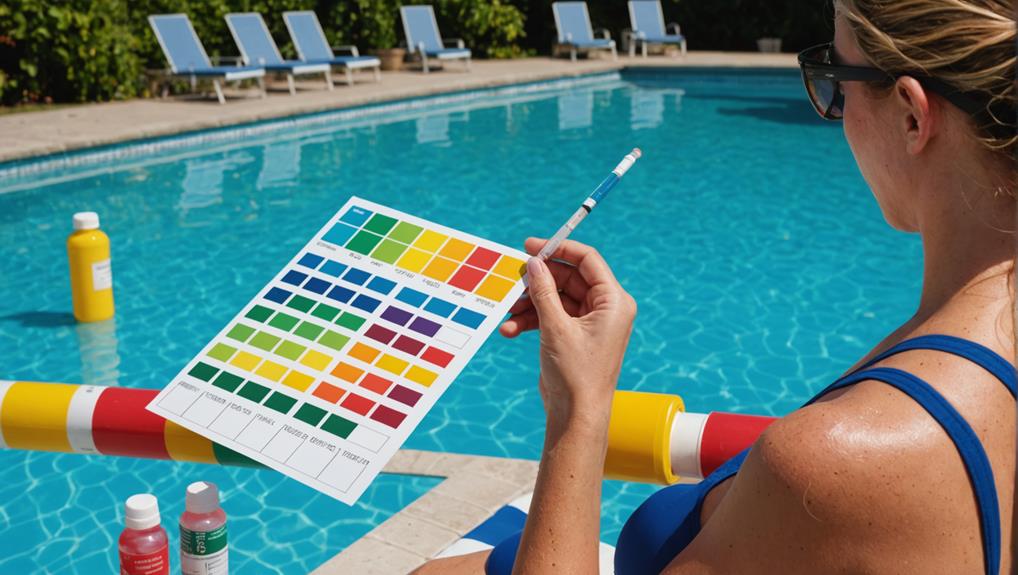You're looking for the best methods for pool chemical testing and analysis to safeguard your pool water is safe and healthy for swimmers. You've got several options: drop-based testing, FAS-DPD testing, digital testing methods, and more. Popular pool test kits include Taylor K-2006, LaMotte ColorQ 2X Pro 7, and Poolmaster 5-Way DPD Test Kit. Regular pH level testing and adjustment are essential, and you should also test for total alkalinity, calcium hardness, and cyanuric acid levels. Sanitizer testing for chlorine and bromine is imperative, and advanced techniques like photometers and spectrophotometers offer high accuracy. You're about to enter a world of precise pool water testing.
Key Takeaways
- Accurate pool chemical testing ensures safe and healthy water for swimmers, preventing eye and skin irritation, and equipment corrosion.
- FAS-DPD testing provides precise free chlorine level measurements, even at low concentrations, for optimal sanitizer performance.
- Digital testing methods offer fast and convenient results, storing test data and providing alerts for out-of-range readings.
- Regular testing of pH, total alkalinity, calcium hardness, and cyanuric acid levels maintains optimal water balance and prevents scaling or etching.
- Advanced testing techniques, like spectrophotometry and titration, provide higher accuracy and precision in measuring pool water chemistry parameters.
Accurate Pool Water Testing Methods
When it comes to ensuring the safety and quality of your pool water, accurate testing methods are essential, and three reliable options stand out: drop-based testing, FAS-DPD testing, and digital testing.
You can use pool test strips or a DPD Test Kit for drop-based testing, which involves adding a reagent to a water sample and comparing the resulting color to a chart to determine the chemical level. This method offers high accuracy and precision in measuring essential parameters like Free Available Chlorine, pH balance, and Total Alkalinity.
FAS-DPD testing is a more advanced method that uses a DPD tablet to measure free chlorine levels, providing accurate readings even at low concentrations.
Digital testing methods, on the other hand, use electronic devices to measure pool water parameters, offering fast and convenient results. Some digital testers can store test data and provide alerts for out-of-range readings.
Best Pool Test Kits for Homeowners
Selecting the right pool test kit for your home pool can be a challenging task, but with a plethora of options available, you must identify the best kits that cater to your specific testing needs. As a homeowner, it's essential to choose a kit that accurately measures chlorine, pH, calcium hardness, and total alkalinity levels to ensure proper pool maintenance.
Here are some top-rated pool test kits for homeowners:
| Kit | Features |
|---|---|
| Taylor K-2006 | FAS-DPD chlorine testing, chlorine and bromine tests, convenient carrying case |
| Taylor K-2005 | DPD tablets, chlorine and bromine tests, steeper learning curve |
| LaMotte ColorQ 2X Pro 7 | Digital readings, eliminates color matching, most expensive option |
| Poolmaster 5-Way DPD Test Kit | Affordable, tests for chlorine, bromine, pH, and total alkalinity |
| AquaChek Select 7-in-1 Strips | Easy to use, includes chlorine and bromine tests, scans results into app |
When selecting a test kit, consider the types of tests you need to perform regularly, the ease of use, and the accuracy of the results. By choosing the right kit, you'll be able to maintain optimal chemical levels and ensure a safe and healthy swimming environment for you and your family.
How to Use Liquid Test Kits
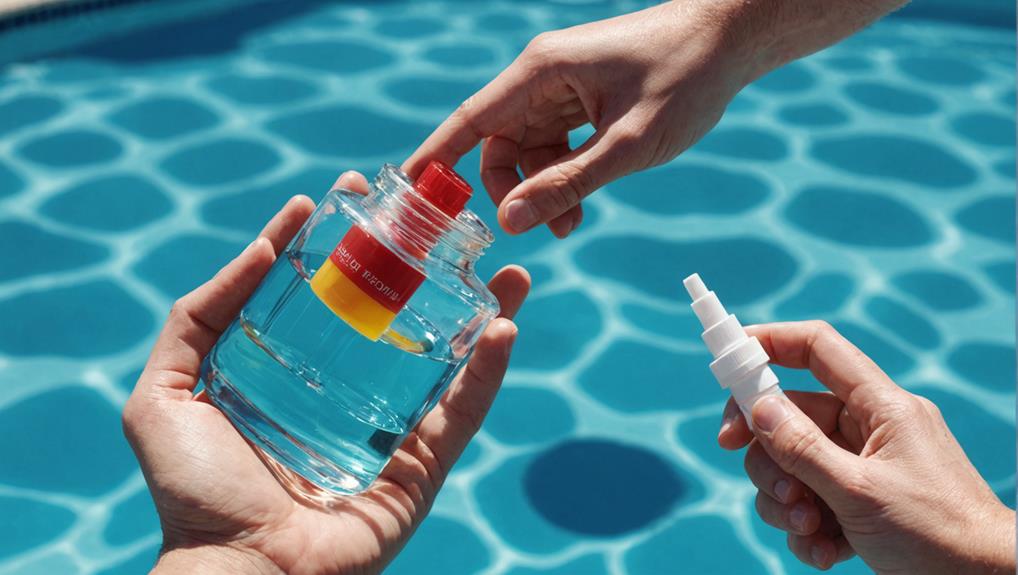
You'll get the most accurate results from your liquid test kit by carefully following the manufacturer's instructions and maintaining the correct ratio of pool water to reagent solution.
This is vital, as even slight deviations can affect the test results.
To use a liquid test kit, fill the provided tube with pool water, add the required reagent solution, and compare the resulting color to the provided chart to determine the chemical level.
Liquid test kits typically measure multiple parameters, including pH, total alkalinity, calcium hardness, and stabilizer levels, making them a thorough testing option.
By following the instructions, you'll be able to accurately determine your pool water's chemical levels, pH levels, and calcium hardness, as well as Total Dissolved Solids.
Regularly testing your pool water with a liquid test kit is essential for proper pool maintenance, as it allows you to adjust the chemical levels accordingly.
With a liquid test kit, you'll be able to achieve accurate results, ensuring your pool water is safe and healthy for swimmers.
Digital Pool Water Testing Options
Two digital pool water testing options are available: handheld testers and in-line monitors, each offering unique advantages and precision in measuring your pool's chemical parameters.
Handheld digital testers are portable and convenient, allowing you to test your pool water anywhere, anytime. They often come with pre-programmed parameters for Total Bromine, pH levels, and other essential readings. Some digital testers can even perform DPD tests, providing accurate readings for chlorine and bromine levels.
In-line monitors, on the other hand, are installed directly into your pool's plumbing system, providing continuous monitoring of your pool water's chemical balance. These monitors can alert you to any changes in your pool's pH levels, Total Bromine, or other parameters, maintaining your pool water's stability and safety for swimmers.
When testing your pool water, digital pool water testing options offer greater accuracy and efficiency compared to traditional testing kits. By investing in a digital pool water testing solution, you'll be able to maintain a perfect pool water balance and guarantee a safe, healthy swimming environment.
Importance of Ph Level Testing
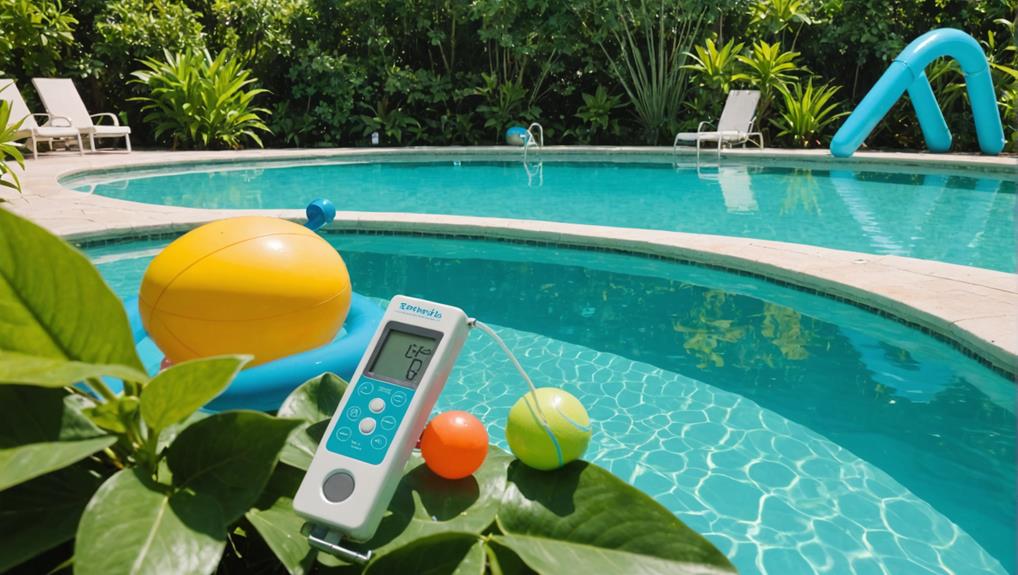
When it comes to maintaining a safe and healthy swimming environment, one of the most critical parameters to monitor is the pH level of your pool water.
You need to verify that your pH levels are within the ideal range of 7.4-7.6 to prevent eye and skin irritation, corrosion of pool equipment, and damage to the pool surface.
If your pH levels are too low or too high, you'll need to use pH adjustment to bring them back in line.
Regular pool maintenance requires frequent pH testing, especially when you first start using your pool.
You should test your pool water daily until you get a sense of how the pH levels fluctuate, and then at least weekly.
Take a water sample and test it to confirm your pH levels are within the ideal range.
Remember, even a slight deviation from the ideal range can have significant consequences for pool maintenance and swimmer comfort.
Measuring Total Alkalinity Levels
Measuring Total Alkalinity (TA) levels is a critical component of pool maintenance, as it directly affects the stability of your pool's pH levels and overall water balance.
You want to verify your TA levels are within the recommended range of 80-120 parts per million (ppm) to prevent pH fluctuations, which can lead to eye irritation, skin rashes, and damage to your pool equipment and surfaces.
When measuring TA levels, keep in mind:
Use a pool test kit or send a water sample to a laboratory for analysis to get accurate results.
If your TA levels are too low, add sodium bicarbonate (baking soda) to increase them.
If your TA levels are too high, add a pH decreaser or muriatic acid to decrease them.
Calcium Hardness Testing and Analysis
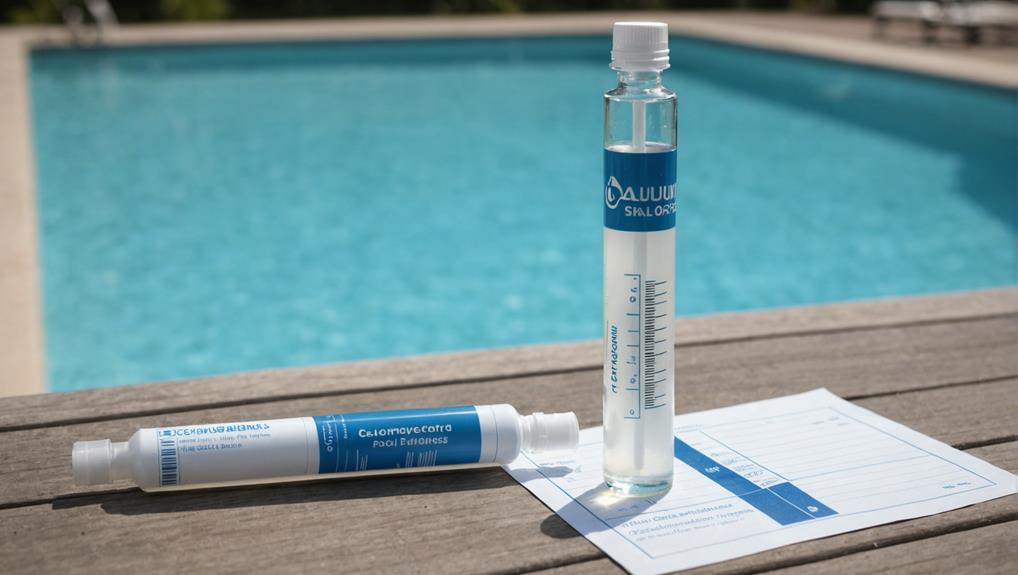
You need to test and analyze the calcium hardness level in your pool water to verify it falls within the ideal range of 200-400 ppm, as this parameter has a significant impact on the overall health and balance of your pool's ecosystem.
Calcium hardness measures the level of calcium ions in the pool water, and maintaining ideal levels is vital to prevent corrosion and scaling. Low calcium hardness levels can cause etching or pitting on the pool surface, while high levels can lead to cloudy water and scaling on the pool walls and equipment.
To test calcium hardness, you'll need a calcium hardness test kit, which involves mixing a reagent with a water sample and comparing the resulting color to a chart to determine the calcium hardness level.
Regular testing is essential to maintain a balanced pool environment, as it can affect the efficacy of sanitizers and the overall health of the pool and its equipment.
If your hardness level is off, you can adjust it by adding calcium chloride or calcium increaser products to the pool water, following the manufacturer's instructions to achieve the ideal level.
Cyanuric Acid Testing for Stabilizer
Testing cyanuric acid levels is a vital step in maintaining a stable chlorine level in your pool water, as it helps prevent chlorine degradation due to sunlight and guarantees proper sanitizer performance.
You should aim to keep the cyanuric acid level between 30-50 parts per million (ppm), as levels below 30 ppm can cause chlorine to degrade rapidly.
To test cyanuric acid levels, you can use a pool test kit or send a water sample to a laboratory for analysis.
Regular testing helps prevent eye irritation, respiratory problems, and skin rashes caused by improper chlorine levels.
Some key points to keep in mind:
- Cyanuric acid levels can be adjusted by adding a stabilizer or conditioner to the pool water.
- The ideal cyanuric acid level is between 30-50 ppm.
- Regular testing is essential for maintaining proper chlorine levels and preventing chlorine degradation.
Chlorine and Bromine Sanitizer Testing
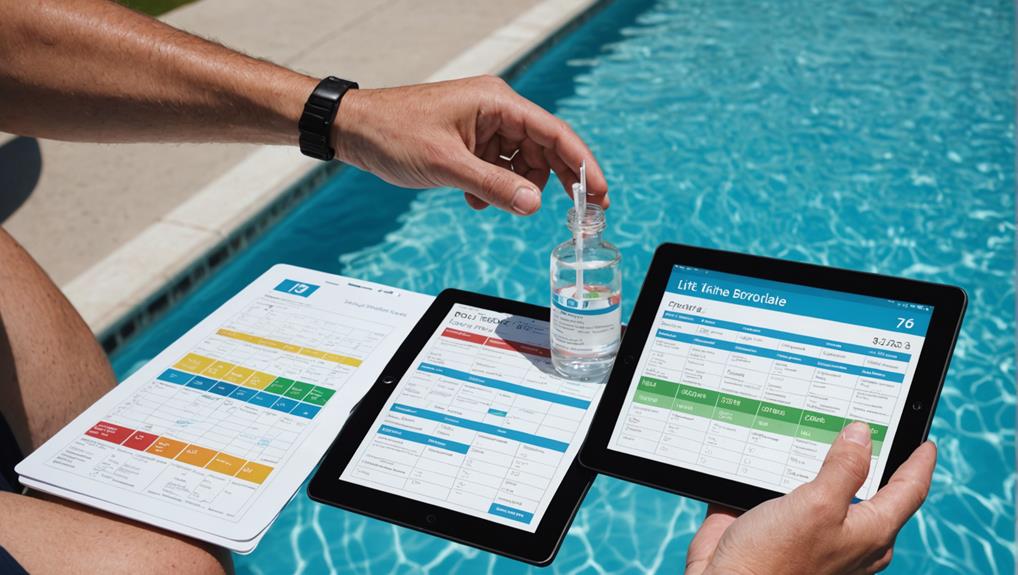
Maintaining the proper levels of chlorine and bromine sanitizers in your pool or spa water is critical to preventing the spread of infectious diseases and maintaining a safe and healthy swimming environment.
To achieve this, you need to test pool water regularly for chlorine and bromine levels. For residential pools, free available chlorine levels should be between 2.0-4.0 ppm, while commercial pools require 3.0-5.0 ppm.
For spas and hot tubs, bromine levels should be between 3.0-5.0 ppm to prevent bacterial growth and maintain water clarity.
Before testing, adjust pH levels to guarantee accurate results, as pH imbalances can affect test outcomes.
You can use test strips, liquid test kits, or digital test kits for sanitizer testing. Liquid test kits provide more accurate results than test strips.
Regular sanitizer testing helps prevent eye and skin irritation, respiratory issues, and the spread of infectious diseases in pool and spa water.
Advanced Pool Water Testing Techniques
Beyond the standard chlorine and bromine sanitizer testing, advanced pool water testing techniques offer a higher level of accuracy and precision in measuring pool water chemistry parameters.
As you explore these advanced methods, you'll discover a range of digital testers, spectrophotometers, and titration methods that provide more accurate and precise readings.
Digital testers, such as photometers and colorimeters, use advanced technology to quickly and accurately measure parameters like chlorine, pH, and alkalinity.
Spectrophotometers measure the concentration of specific substances in pool water, including metals, phosphates, and other contaminants, using light absorption.
Titration methods, such as the DPD method, involve adding a reagent to a pool water sample until a specific reaction occurs, allowing for accurate measurement of chlorine and other parameters.
Frequently Asked Questions
What Is the Most Accurate Way to Test Pool Chemicals?
When you need precise pool chemical testing, you'll find that titration methods, like FAS-DPD, and photometric tests provide the most accurate digital readings, surpassing color charts, strip tests, and pH meters, while calibration checks guarantee reliability, making lab analysis unnecessary.
What Do Professionals Use to Test Pool Water?
You'll find professionals relying on chemical kits, like Taylor K-2006, and digital testers, such as LaMotte ColorQ 2X Pro 7, for accurate pool testing and water analysis, as they provide reliable methods and precise readings that meet laboratory standards and industry practices.
What Order to Test Pool Chemicals?
When establishing your daily routine, you'll prioritize chemical testing by frequency, starting with pH, then alkalinity, calcium hardness, and stabilizer, considering water conditions, seasonal variations, and visual inspection to confirm accurate results.
In What Order Should I Balance My Pool Chemicals?
As pool season approaches, you'll want to tackle chemical priorities in the right order. First, verify water clarity with alkalinity checks and pH adjustment, then address calcium hardness and chlorine demand, followed by stabilizer levels and sanitizer efficiency to avoid shock treatment.
Conclusion
By mastering the 10 best methods for pool chemical testing and analysis, you'll maintain a safe and healthy swimming environment.
For instance, consider the case of the Oakwood Community Pool, which reduced eye irritation complaints by 90% after implementing regular calcium hardness testing and adjusting their levels accordingly.
By staying on top of your pool's chemical balance, you can achieve similar results and enjoy a hassle-free swimming experience all season long.

I’m Max, the founder and chief pool enthusiast behind Pool Pro Tips. As a passionate pool owner and cleaning expert, I created this website to share my knowledge and experience with you, helping you to keep your pool sparkling clean and safe for years to come.

